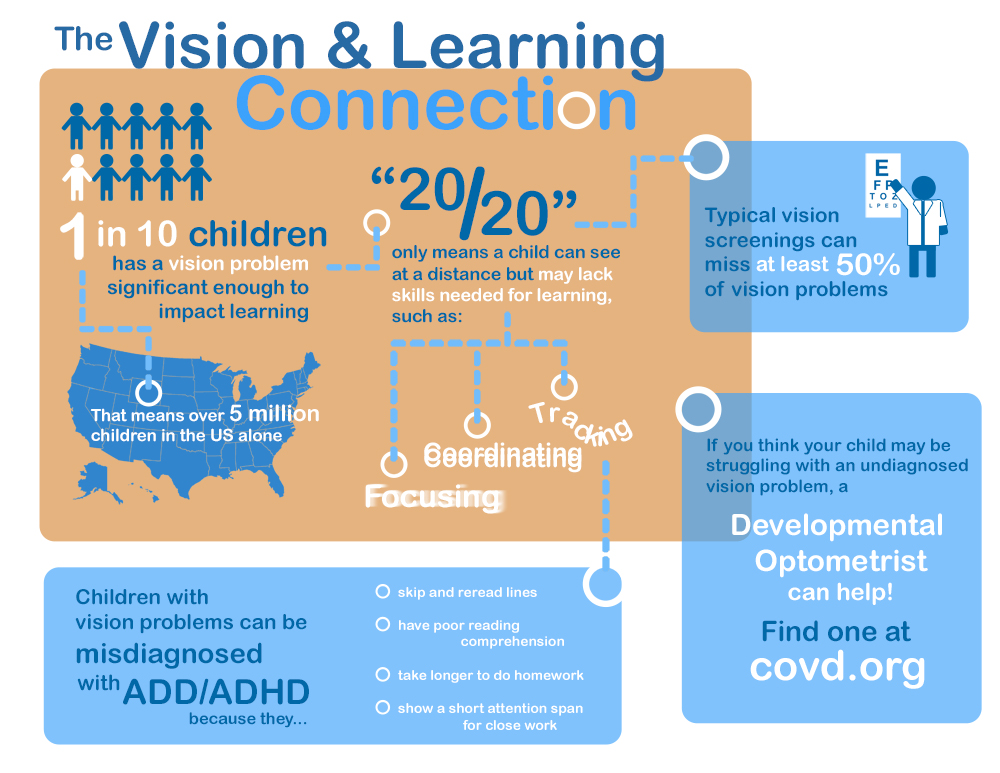Vision and Learning
According to the American Optometric Association (AOA), up to 80% of a child's learning in school is through vision. Also, according to a 2015 statement from the College of Optometrists in Vision Development (COVD),
“More than 5 million children in the U.S. have eye coordination and eye focusing disorders which cause them to continue struggling with reading despite the best interventions....Children don’t know how they are supposed to see, so they rarely complain; they show us they have a problem with their behavior.”
Visual Skills for Learning
Most people do not realize how many visual skills are necessary for learning. Unfortunately, the emphasis (including school screenings) is mostly on visual acuity. Visual acuity only gives part of the picture. Other skills such as eye teaming, focusing, and visual tracking are not evaluated in school screenings and often go unevaluated. Eye coordination and eye focusing problems can make learning difficult; they can make the words appear blurry, double, or look like they are moving.
The College of Optometrists in Vision Development (COVD) website outlines at least 17 visual skills necessary for learning. Other resources, such as the book "The Hidden Link Between Vision and Learning: Why Millions of Learning-Disabled Children are Misdiagnosed" by Wendy Rosen, outline more. These visual skills include: Eye Movement Control, Eye Teaming, Vergence, Convergence, Divergence, Focus Accommodation, Depth Perception or Depth Awareness, Peripheral Vision, Visual Motor Integration, Visual Spatial Skills, Visual Memory, Visual Form Recognition, Visualization, and near and far visual acuity.
You can also visit our wiki page on Visual Skills for more information.

Vision Screenings
According to the College of Optometrists in Vision Development (COVD), the majority of vision screenings performed in schools and pediatricians’ offices are not designed to test for problems with eye coordination, tracking, or focusing. In fact, vision screenings miss at least 50% of vision problems. In addition, general eye exams often do not thoroughly evaluate all the visual skills required for academic success.
Common signs a vision problem may be impacting learning
5 Common signs that a vision problem may be interfering with reading and learning are:
- Difficulty completing homework
- Inattentive or easily distracted
- Loss of place when reading - skips or re-reads lines.
- Eyes are uncomfortable or sore when reading
- Gets tired when reading
Treatment
In a 2014 statement, the President of the College of Optometrists in Vision Development (COVD), Dr. Ida Chung, stated,
“When a vision problem is at the root of a child’s struggles with learning, it is often very correctable....This is good news for parents and educators. Often years of struggling can be turned around with a program of optometric vision therapy.”
Optometric Vision Therapy is:
- Conducted under the supervision of an optometrist
- Often administered or guided by a vision therapist employed by the overseeing optometrist
- Supported by ongoing, evidence-based scientific research
- Typically supplemented by the use of lenses, prisms, filters, and 3-D activities, among other things
- Individualized to the unique needs of the patient
- Beneficial to patients of all ages
- Non-invasive and in some cases can be a safe alternative to surgery
You can find a vision therapy specialist near you!
Vision and Learning References
Watch this webinar on Vision and Learning by Dr. Angela Peddle presented on I HEART VT in August 2020:
The Hidden Link Between Vision and Learning: Why Millions of Learning-Disabled Children are Misdiagnosed by Wendy Beth Rosen
PRESS RELEASE: 20th Anniversary of August is National Children’s Vision and Learning Month: Eye Coordination Problems Can Make Words “Hop Like Frogs”
PRESS RELEASE: Vision Problems Masquerade as Learning Disabilities
Vision Problems Impact Learning in at least 5 million children:
Borsting E, Rouse M, Deland P, Hovett S, Kimura D, Park M, et al. Association of symptoms and convergence and accommodative insufficiency in school-age children. Optometry. 2003;74:25-34. http://www.ncbi.nlm.nih.gov/pubmed/12539890
Rouse M, Borsting E, Hyman L, Hussein M, Cotter S, Flynn M, et al. Frequency of convergence insufficiency among fifth and sixth graders. Optom Vis Sci. 1999;76:643-9. http://www.ncbi.nlm.nih.gov/pubmed/10498006
School Screenings Miss 50% of Vision Problems
Borsting E, Rouse M, Deland P, Hovett S, Kimura D, Park M, et al. Association of symptoms and convergence and accommodative insufficiency in school-age children. Optometry. 2003;74:25-34. http://www.ncbi.nlm.nih.gov/pubmed/12539890
Eye coordination problems can be mistaken for ADHD:
Borsting, E., M. Rouse and R. Chu (2005). "Measuring ADHD behaviors in children with symptomatic accommodative dysfunction or convergence insufficiency: a preliminary study." Optometry 76: 588-592. http://www.ncbi.nlm.nih.gov/pubmed/16230274
Borsting, E., G. L. Mitchell, L. E. Arnold, M. Sheiman, C. Chase, M. Kulp, S. Cotter and C. R. Group (2013). "Behavioral and Emotional Problems Associated With Convergence Insufficiency in Children: An Open Trial." J Atten Disord. http://jad.sagepub.com/content/early/2013/11/22/1087054713511528
Granet DB, Gomi CF, Ventura R and Miller-Scholte A (2005). "The relationship between convergence insufficiency and ADHD." Strabismus 13: 163-168. http://www.ncbi.nlm.nih.gov/pubmed/16361187
Vision problems can block learning:
Barnhardt C, Cotter SA, Mitchell GL, Scheiman M, Kulp MT. Symptoms in children with convergence insufficiency: before and after treatment. Optom Vis Sci. 2012;89(10):1512-20. http://www.ncbi.nlm.nih.gov/pubmed/22922781
Rouse M, Borsting E, Mitchell GL, Kulp M, Scheiman M, Amster D, et al. Academic Behaviors in Children with Convergence Insufficiency with and without Parent-Reported ADHD. Opt Vis Sci. 2009;86:1169-77. http://www.ncbi.nlm.nih.gov/pubmed/19741558
Borsting E, Mitchell GL, Kulp MT, Scheiman M, Amster DM, Cotter S, et al. Improvement in academic behaviors after successful treatment of convergence insufficiency. Optom Vis Sci. 2012;89(1):12-8. http://www.ncbi.nlm.nih.gov/pubmed/22080400
Eye coordination and focusing problems are treatable:
Convergence Insufficiency Treatment Trial (CITT) Study Group. Randomized clinical trial of treatments for symptomatic convergence insufficiency in children. Arch Ophthalmol. 2008;126:1336-49. http://www.ncbi.nlm.nih.gov/pubmed/18852411
Sterner B, Abrahamsson M, Sjostrom A. The effects of accommodative facility training on a group of children with impaired relative accommodation--a comparison between dioptric treatment and sham treatment. Ophthalmic & physiological optics : the journal of the British College of Ophthalmic Opticians (Optometrists). 2001;21(6):470-6. http://www.ncbi.nlm.nih.gov/pubmed/11727875
The Vision Wiki
- Binocular Vision
- Vision Tests
- Suppression Tests
- Worth 4 Dot
- Tests of Stereopsis
- Cover Test
- Definitions
- Signs and Symptoms
- Blurry Vision
- Reading Problems
- Eye Strain
- Driving Problems
- Headaches
- Suppression
- Double Vision
- Motion Sickness and Car Sickness
- Pias Vision
- Visual Skills
- Visual Tracking
- Visual Fixation
- Stereopsis
- Depth Perception
- Visual Accommodation
- Visual Requirements for Baseball
- Visual Requirements for Pilots
- Reading
- Foundational Reading Skills
- Vision and Learning
- Fusion
- Convergence and Divergence
- Reading Skills
- Visual Processing
- Eye Problems
- Physiology of Vision
- Lazy Eye
- Lazy Eye Treatments
- Reading
- Fields of Study
- Research
- Glaucoma
- Virtual Reality
- Organizations

